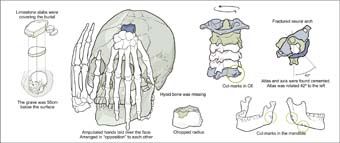
The results of an international study change the traditional ruling vision on the ritual of the decapitation in America: neither is a phenomenon based in the Andes nor, as it was believed, relatively recent. This is illustrated by the research carried out and lead by André Strauss, of the Max Planck Institute of the Evolutionary Anthropology, and with the participation of Domingo Carlos Salazar-García, from the Department of Prehistory and Archaelogy of the Universitat de València.
Few Amerindian traditions impressed so much to the European colonists as the amputation and the exhibition of parts of the human body, and moreover when it was decapitation. Although some authors still discuss it, the archaeological evidence confirms that this practice has chronologically deep roots and that the ritual of decapitation is widely accepted as a common practice among the American natives all over the continent. At South America, the oldest decapitation dated with clarity until today is in the Andean Region (Asian site, Peru) and dates back to around 3.000 years. And as all the South American archaeological finds were located in the Andes (Inca, Nazca, Moche, Wari, Tiwanaku), it was supposed that the decapitation was an Andean phenomenon. But the results of the research lead by André Strauss and with the participation of the Valencian researcher Domingo Carlos Salazar-García, published in Plos One, have also revealed a case of 9.000 years old and in a different area, as it is the case of the stone refuge of Lapa do Santo, in Brazil.
The burial in Lapa do Santo has provided evidence of human occupation of about 12.000 years ago. In this burial (Burial 26) the researches found in 2007 pieces of a buried human body, with a cranium, a mandible, the first six vertebrae, and two hands. By using the accelerator mass spectrometry, the researchers dated the remains of 9.000 years old. They found the hands arranged over the face of the cranium, one upward and the other downward, and they observed marks in a V form in the mandible and in the sixth cervical vertebra.
Although the occidental perspective has understood many times the decapitation as a way of violence among groups and as a punishment, the points of the archaeological and ethnographic registration offer a new scenario more complex in the New World. According Domingo Carlos Salazar-García, responsible of the isotopic studies, “the comparative analysis of the strontium in the Burial 26 with other specimens from Lapa do Santo is a part of the study that suggests that the remains were from a local member of the group and not from a defeated foreign enemy.” Besides, the presentation of the remains took the authors to think that “the scene probably represents a ritual decapitation and not a prey as a trophy.” If this is this way, the remains can prove sophisticated mortuary rituals among the hunter-gatherers in the Americas during this period. In the opinion of Strauss, “this ritualised case of decapitation of Lapa do Santo testifies the primitive sophistication of the mortuary rituals among the hunter-gatherers in the Americas. The lack of a punishment element has given way to consider that it is a practice that expresses a radical notion of the otherness.” As apparently they did not had sumptuous objects nor a developed architecture, it seems that the inhabitants of Lapa do Santo used the human body to treat as objects and express their cosmological principles, explains Salazar-García.
The authors believe that this may be the oldest case of decapitation of the New World, which leads to a new evaluation of the prior interpretations of this practice, specially for everything concerning their origins and geographical extension.
Last update: 23 de september de 2015 03:00.
News release



















